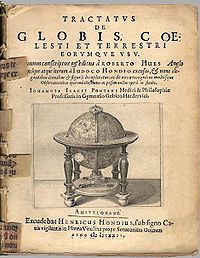Robert Hues | |
|---|---|
 The title page of a 1634 version of Hues' Tractatus de globis in the collection of the Biblioteca Nacional de Portugal | |
| Born | 1553 Little Hereford, Herefordshire, England |
| Died | 24 May 1632 (aged 78–79) Oxford, Oxfordshire, England |
| Alma mater | St Mary Hall, Oxford (BA, 1578) |
| Known for | publishing Tractatus de globis et eorum usu (Treatise on Globes and their Use, 1594) |
| Scientific career | |
| Fields | Mathematics, geography |
Robert Hues (1553 – 24 May 1632) was an English mathematician and geographer. He attended St. Mary Hall at Oxford, and graduated in 1578. Hues became interested in geography and mathematics, and studied navigation at a school set up by Walter Raleigh. During a trip to Newfoundland, he made observations which caused him to doubt the accepted published values for variations of the compass. Between 1586 and 1588, Hues travelled with Thomas Cavendish on a circumnavigation of the globe, performing astronomical observations and taking the latitudes of places they visited. Beginning in August 1591, Hues and Cavendish again set out on another circumnavigation of the globe. During the voyage, Hues made astronomical observations in the South Atlantic, and continued his observations of the variation of the compass at various latitudes and at the Equator. Cavendish died on the journey in 1592, and Hues returned to England the following year.
In 1594, Hues published his discoveries in the Latin work Tractatus de globis et eorum usu (Treatise on Globes and Their Use) which was written to explain the use of the terrestrial and celestial globes that had been made and published by Emery Molyneux in late 1592 or early 1593, and to encourage English sailors to use practical astronomical navigation. Hues' work subsequently went into at least 12 other printings in Dutch, English, French and Latin.
Hues continued to have dealings with Raleigh in the 1590s, and later became a servant of Thomas Grey, 15th Baron Grey de Wilton. While Grey was imprisoned in the Tower of London for participating in the Bye Plot, Hues stayed with him. Following Grey's death in 1614, Hues attended upon Henry Percy, the 9th Earl of Northumberland, when he was confined in the Tower; one source states that Hues, Thomas Harriot and Walter Warner were Northumberland's constant companions and known as his "Three Magi", although this is disputed. Hues tutored Northumberland's son Algernon Percy (who was to become the 10th Earl of Northumberland) at Oxford, and subsequently (in 1622–1623) Algernon's younger brother Henry. In later years, Hues lived in Oxford where he was a fellow of the University, and discussed mathematics and related subjects with like-minded friends. He died on 24 May 1632 in the city and was buried in Christ Church Cathedral.